Review: Motorola Moto G for AT&T
Oct 2, 2014, 3:30 PM by Eric M. Zeman
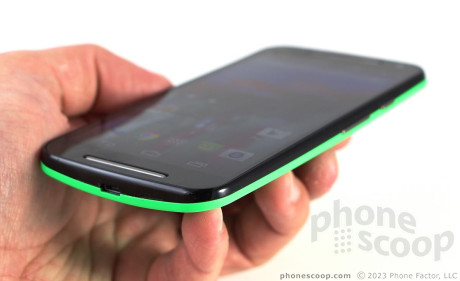
Motorola's second-generation G earns solid marks thanks to tasteful improvements to the hardware and evolutionary improvements to the specs. It's a mid-range middleweight that puts up a good fight amongst its competitors.
Form
Is It Your Type?
The second-generation Moto G is a bit of an evolutionary update to the first-generation model. It's bigger and better in some respects, but loses the compact nature of the first device. It's a full-sized phone. The new Moto G should appeal to budget-conscious shoppers who prefer a simplified Android experience and a straight-forward approach to the hardware.
Body
Motorola gave the second-gen Moto G a nominal boost in specs and size. Thanks in part to the bigger display, the phone is noticeably larger than last year's model. The general concept is the same. It borrows heavily from the design Motorola debuted in 2013 with the X, G, and E handsets. The G has what we can call "the Motorola look." Its lineage is not in question at all.
I'd say the second-gen model looks a wee bit spiffier than the first-gen model. The materials look and feel slightly better, and the addition of some chrome accents helps lend the G some much-needed class. The front is all shiny and glossy glass, and the back is all matte plastic. It's sort of a Jekyll/Hyde thing, if you ask me, but Motorola makes it work. Buyers will be able to choose between white or black fronts and can then customize the rear by swapping out the covers with various color options.
The phone measures 5.57 x 2.78 x 0.43 inches. That makes it taller and wider than last year's phone, but it is slightly thinner in the front-to-back dimension. The curved back surface helps the G fit better in the hand, that's for sure. It's not a small phone, and is close to a number of flagships in terms of overall footprint, but it isn't overly bif. In fact, I'd still call it a one-handed phone (though it's pushing up against the limit).
The build quality is good. The glass front has a really nice feel under the thumb. The rear cover fits snugly; the seam is nice and tight. There are no unsightly gaps. It's not rugged, but it doesn't feel dainty either.
The G's front face is nicely broken up by two chrome bars, one above the display and the second below. They cover the earpiece and microphone, respectively, and serve as stereo speakers. (It's a bummer you can't customize the colors to match the back, though.) There are no front buttons, as the G uses the on-screen controls offered by the Android operating system.
All of the G's buttons are on the right edge. The screen lock button is closer to the top and the volume toggle is closer to the middle. Both buttons have low profiles, but are far enough apart that you shouldn't mistake one for the other. Travel and feedback of both controls is unacceptably awful. They are mushy and barely spring back once pressed. Motorola could have done a much better job with these buttons. The headphone jack is on top and the microUSB port is on the bottom. Both of those function fine.
The rear shell is removable, but it's a bit of a pain in the... rear. The clasps holding it in place are rather strong, and I was forced to break out my knife to pry the cover off. Having interchangeable covers is welcome, as it allows people to customize the look of their phone at least a little bit. The SIM card and memory card slots are accessible once the cover is removed, but the G's battery is built in; you can't pull it or swap it.
In all, the second-gen Moto G is a decent piece of hardware. I'd call it slightly bland, but there are worse things a smartphone can be.
Performance
Screen
Motorola boosted the G's screen from 4.5 inches to 5 inches, but kept the 720p resolution unchanged. That means fewer pixels per inch, if you're counting. It's not the sharpest-ever display, I can say that much. Pixels are visible when the phone gets to within a foot of my eyes, but that's probably only because I'm looking for them. Icons and text are reasonably sharp and colors look great. Like the second-gen Moto X, however, I find the G's screen just isn't bright enough for outdoor use. Viewing angles are much better, though, as there is no color shift and no brightness drop off. For a mid-range smartphone, the G's screen offers relatively little to complain about.
Signal
One of the G's biggest limitations is its support for cellular technology - or, more precisely, the lack thereof. The G is limited to HSPA+ and does not support LTE. That's a major bummer. That said, the G performed very well on AT&T's HSPA+ network in and around the metro NYC area. It remained connected no matter where I took it, and managed to make calls even under the weakest signal conditions. Data performance was acceptable and not too terribly far off what AT&T's LTE network offers. Weak signal definitely slowed down data performance, but not any more so than it does on other handsets. In sum, the second-gen G does well in the signal department.
Sound
Wow. The Moto G has one of the loudest earpiece speakers I've tested this year. It produces staggeringly loud voices and pumps them into your ear at decibel levels that are best left for your local dance club. You can't put the volume all the way up and hold the G to your head; it'll overwhelm you. The quality of calls was a bit on the scratchy side. Even with the volume set at a modest 50%, calls were full of crackles. The occasional interference didn't make conversations unintelligible, though, and I was able to talk to people in loud and quiet environments with no problem. The speakerphone was also loud, though not as loud as I was expecting given the earpiece's potent powers. Quality of voices coming through the speakerphone were rather sketchy, but not the worst. People with whom I spoke through the G said I sounded really clear. Ringers and alert tones are plenty loud. I had no trouble hearing in-coming calls, even in spaces that were noisy. The vibrate alert is decent. It could be stronger, but it's not terribly weak.
Battery
Like many other specs, Motorola carried over the 2,070 mAh battery from last year's model. The lack of 4G and the slightly lower-res screen help keep power use in check. The G's battery generally pushed through an entire waking day 8 AM - midnight with no trouble. I ran into trouble a couple of times around 9 PM, but that was under abnormally heavy usage. With normal use, most users can expect to make it from breakfast to bedtime without issue.
Unlike competing models, the Moto G doesn't include a special battery-saver mode. You have to manage it all on your own. Thankfully, that's not too much of a chore.
Basics
Menus
The Moto G runs a nearly unmolested version of Android 4.4 KitKat. The software build is closely matched to that of the Moto X, minus a couple big bullet points. The G will be among the first wave of handsets to receive the Android L release, which is expected in just a few short weeks. The phone also comes with a handful of apps developed by Motorola to make the device more useful.
Sadly, the G doesn't have one of the X's best features, which is Active Display. That means the lock screen is a rather static and boring space. It supports the usual set of passwords and other protections, but not the on-again / off-again notifications available to the X. There's one shortcut on the lock screen, and that's to the camera.
The rest of the menus operate exactly as they do on any KitKat phone. There are minimal home screens active out of the box, and they aren't littered with widgets and shortcuts. In other words, it takes only a few moments to customize the panels to suit your own needs. The app menu is laid out in a clean grid. Apps are listed alphabetically, but you can drop them into folders if you want. There's no list view option.
The settings menu offers white text on a black background, which we've seen from Android since 4.0 hit the ground. Motorola hasn't dressed the settings up at all. It is a simple and straight-forward tool for managing the G. Similarly, the notification shade is devoid of extras, like toggles for the radios built into the main screen. Instead, it offers only notifications and access to the Quick Settings with a two-finger swipe.
Motorola stuck with the Qualcomm Snapdragon 400 for the G, the same chipset as last year. I'm a bit disappointed Motorola didn't upgrade the processor at all, but I understand the company is trying to keep the price down. I didn't notice any hiccups in performance while reviewing the phone, though I'd say the G is a bit slower at downloading and installing apps and app updates than the Moto X is. The G compares well, however, to other phones in its own class (many of which are using the same processor).
Calls and Contacts
The phone app is among the default shortcuts pasted into the dock at the bottom of the screen. Pressing the phone button dials up the stock Android phone app. You can swipe sideways to access the call log and your favorite contacts. The call log provides some information about calls (time, duration) in addition to shortcuts for redialing or sending a text message to those numbers.
Contacts are automatically synced with your Google accounts if you use Gmail, but also support ActiveSync, Exchange, and IMAP databases. Contact cards — or direct dial or direct message shortcuts — can be placed on the home screens, which give you instant access to your close contacts. You can also add people to your Favorites list, which is visible in the phone app and includes a homescreen widget. These standard Android calling and contact apps function well enough, though I find they aren't as intuitive as they could be. They perform well on the Moto G.
Messaging
The Moto G comes with the same stock Android communications apps that are on every other Android device. That means Gmail, email, messaging, Hangouts, and Google+. The older messaging app is the default SMS/MMS client when you first boot the Moto G. You can switch the default messaging app to Google Hangouts if you want, but you don't have to. The messaging apps on the Moto G function just as well as they do across the range of Android phones out there. AT&T didn't stick any of its own messaging apps or services on the G.
Moto Apps
The G loses Moto Voice and Moto Connect, but keeps Moto Assist and Moto Migrate. The G doesn't have the X's co-processor so it can't handle Moto Voice. This is part of how Motorola was able to keep the cost down.
Moto Assist
Moto Assist helps users manage notifications to prevent interruptions, such as when sleeping, when driving, and when in meetings. It automatically detects when you're driving, and can be set to enter sleep mode on a set schedule, if you wish. It also knows when you're in meetings. You can also allow select contacts to break through sleep mode. It's a useful tool, but has been replicated by most other smartphones these days.
Migrate
Moto Migrate is meant to help you transfer all of your content from one device to another. It works with media, call and text history, as well as SIM contacts. The tool makes use of a QR code scanner to pair the two devices and then uses Google's servers to migrate the data between the phones. It makes it pretty easy to send data to another device. This functionality now also works with feature phones and can be used to transfer contacts through a Bluetooth connection. That makes the G a bit more appealing for someone switching to their first smartphone.
Extras
Media
The Moto G ships with the core Google Play apps for content consumption. These apps are available to all Android devices. I find they work well for handling each different type of content available in the Play Store, including music, movies, TV shows, books, and magazines. The G also throws in an FM radio for good measure. The radio works well, but you need to use a pair of headphones (as an antenna) to get any reception.
Music sounds good when played back through my fave set of earbuds, and the screen does a good job with video content. I've been catching up on "The Walking Dead" lately, and it looked great on the G. The stereo speakers are definitely helpful when watching a video with friends and put out plenty of sound to accompany the visuals.
Camera
The G uses the exact same camera software Motorola used on the X. It is rather bare bones, but functions well enough for a device such as the G. It opens quickly from the lock screen or the home screens, but the G loses the X's gesture-based launch function.
The camera UI is spartan. There are only two buttons: one for the video camera and another for the user-facing camera. (Every so often, a little "?" appears in the upper right corner. If you're confused about how to use the camera, this offers you a helpful tutorial.) The controls can only be accessed by swiping from the side of the viewfinder towards the center. Swiping from the left opens the control dial that has most of the options. The Moto G includes HDR (which can be set to come on automatically) and panorama shooting modes.
Want to zoom? Drag your finger up or down. (When you first launch the camera, these actions are explained.) Perhaps the one thing I really like is that the camera has an always-on burst mode. Press the screen and hold, and the G will focus and then fire of two shots per second until you take your finger off the screen.
The camera software is a step up from stock Android, but barely. You can't adjust scenes, ISO, brightness, or white balance. You can toggle GPS tagging on/off; set the flash to auto, on, or off; choose the aspect ratio for your photos: and toggle on/off the exposure lock feature.
The G is a tad slow to focus and capture images. The burst function works very fast, but when shooting single images there's a noticeable delay between pressing the screen and when the G focuses and fires the shot.
Photos
Motorola improved the G's camera sensor from 5 megapixels to 8. In general, it produces good images. I saw some problems here and there, such as soft focus, grain, or incorrect exposure, but none of them were disastrously awful. White balance was pretty much always accurate. The bulk of photos were solid. I can say with certainty that the auto HDR function saved some photos that otherwise would have been under/over exposed in some areas. Considering where this device falls in AT&T's lineup, it includes a competitive camera with which most people will be pleased.
Video
Video is a somewhat different story. First, the G can only capture 720p HD resolution (at regular speed or slow-motion). Like photos, the video results are generally good, but I saw consistent trouble with exposure. The G had a hard time balancing out subjects that had a dark foreground and bright background. The result, most often, was a too-dark foreground and a properly exposed background. This doesn't work if your subject is in the foreground. Focus and white balance weren't problematic. The G suffices for snagging everyday video, but special occasions might warrant better gear.
Gallery
The Moto G includes both the stock Android gallery app and Google's Photo+ app. The stock gallery app is the same one that comes with most Android devices. It doesn't offer anything new or different compared to other KitKat phones. It is acceptable for managing photo albums and sharing photos with social networks. It also has a some simple editing features, such as crop, rotate, red-eye reduction, and filters that help correct color, exposure, and other issues.
The Photo+ app has a more generous set of editing functions, and can be used to back-up and interact with your photos on Google+ (for those of you who still use it).
Apps
AT&T didn't stuff any apps onto the Moto G, and for that I am thankful. It comes completely free of bloatware. Huzzah!
Bluetooth
I successfully paired the Moto G with my car, headphones, and laptop. Calls routed through my car's hands-free system were loud enough, but rather sketchy in the quality department. It synced my contact data to my car flawlessly. Music sounded pretty good when sent to my fave stereo Bluetooth headphones, but I've heard better. I had no trouble passing files from the Moto G to other nearby devices.
Browser
The Moto G ships with just Chrome on board. The newest rendition of Chrome is solid when it comes to rendering web sites, be they optimized for mobile or not. Web sites looked good and functioned well on the G. I found the G to be quick when surfing on Wi-Fi, but page load times were definitely slower over HSPA+ compared to LTE. AT&T's HSPA+ network is solid, but it's just not as quick as LTE.
Clock
The G's lock screen offers a simple digital clock. The font is white and the numbers are a wee bit thin for my tastes. You do have to be careful about your wallpapers, as they can obscure the clock at times. Otherwise it's generally easy to read.
GPS
Google Maps is the only navigation tool installed on the G. I found it functioned quite well. The GPS radio was quick to locate me, and I'd estimate accuracy is within about 25 to 35 feet. Maps is a great tool for planning routes or searching for nearby points of interest. Of course, there are tons of alternatives in the Play Store.
Wrap-Up
Motorola crafted a worthy follow-up to the first-generation handset. The Moto G is a solid handset that fits somewhere between entry-level and mid-range.
The design is a bit more appealing than last year's phone, and the build quality of the device is moderately improved, as well. I am generally pleased with the 720p HD screen; calls are insanely loud, though not always clear; and battery life is quite respectable. One of my biggest complaints is the lack of LTE 4G. AT&T's HSPA+ service is decent, but LTE is better. With that said, leaving out LTE may be the reason Motorola was able to make the price tag fairly low.
The Moto G runs a clean version of Android that's free of annoying bloatware. The stock Android tools perform just fine on the G. The camera software is rather thin, but the Moto G produces images that exceeded my expectations for this class of device.
The Moto G's price point is a big part of its story, but it's not the whole story. Motorola is selling the G directly to consumers for $180. That's unlocked, without a contract. Considering all the Moto G offers, that's a hell of a price. When you look at other devices in this price range (ZTE Max, LG Volt 4G, HTC Desire 510), the Moto G emerges as one of the best options.
Comments
No messages

















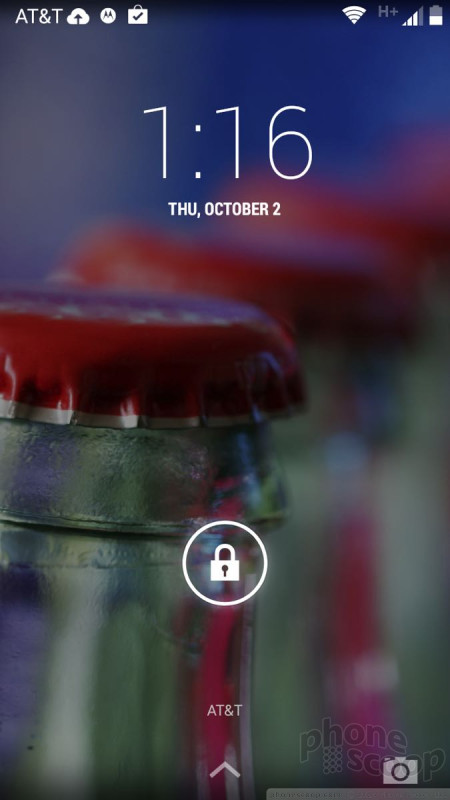














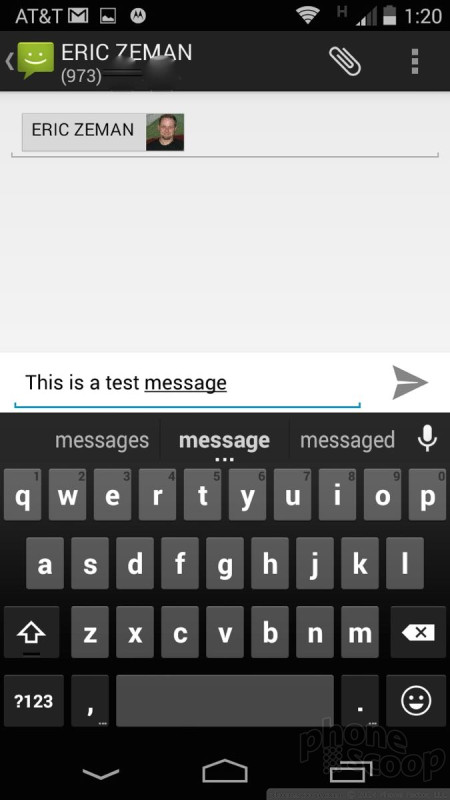




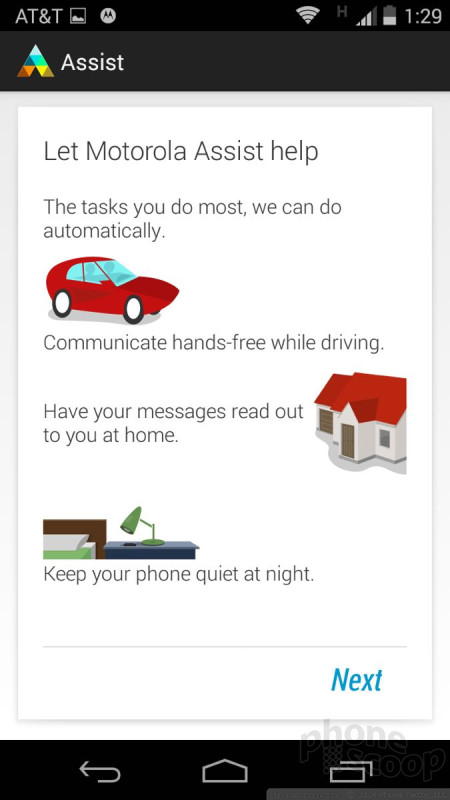

































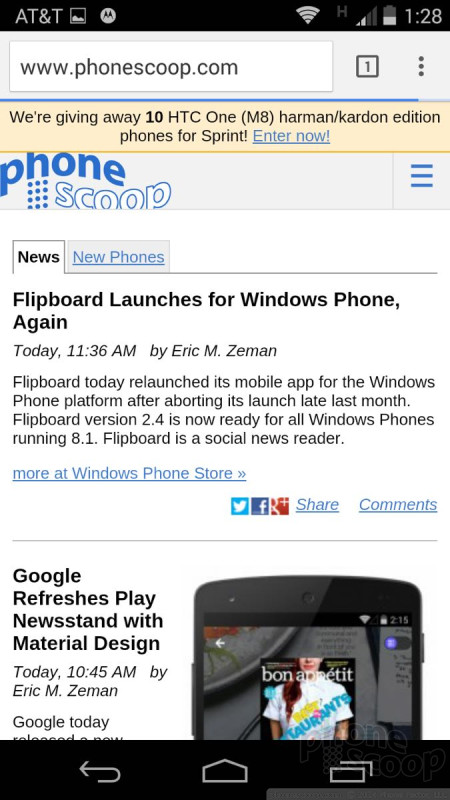



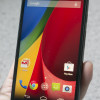 Hands On with the new Moto G
Hands On with the new Moto G
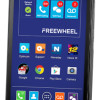 Cablevision Launching FreeWheel WiFi-Based Phone
Cablevision Launching FreeWheel WiFi-Based Phone
 Motorola Pushing Lollipop to Moto X and Moto G
Motorola Pushing Lollipop to Moto X and Moto G
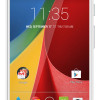 Moto G Goes Full-Size
Moto G Goes Full-Size
 Motorola Moto G (GSM, 2nd gen.)
Motorola Moto G (GSM, 2nd gen.)







